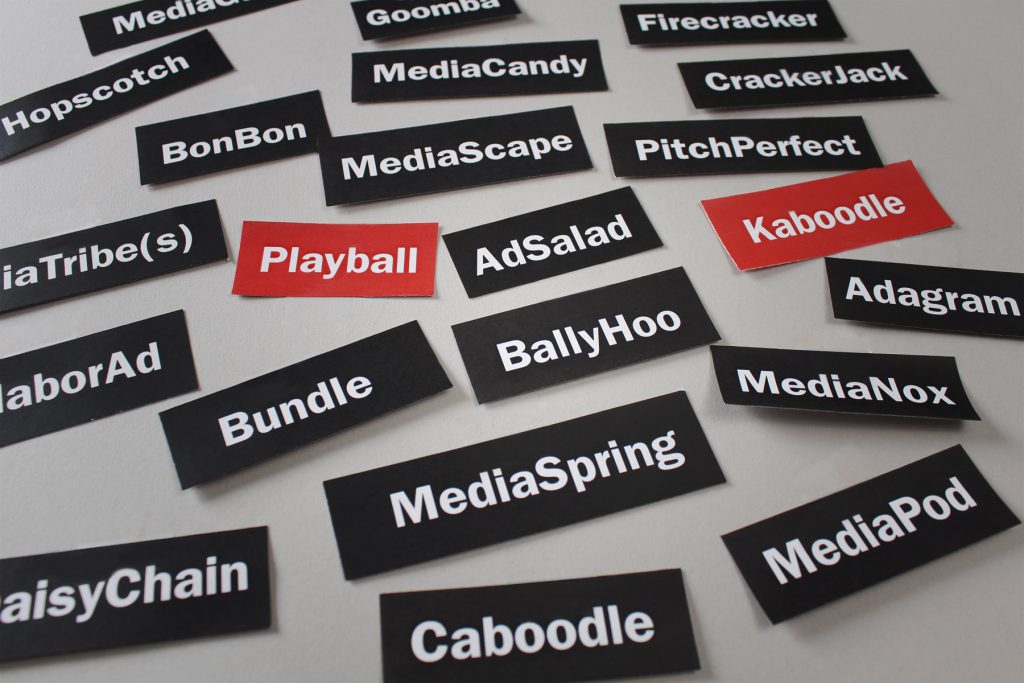Grey matters
How to create a great brand name for your business
At some point in your career you may be leaving the comfort of your permanent job role to do something silly, like starting up a new business. In our experience the actual brand name of a new business is the most important ingredient of the new business identity. All too often, would-be entrepreneurs hurriedly throw together a name blended from their first pet and their favourite colour. No, that’s probably not the smartest move. If you are going to do this yourself, here is how to create a great brand name in an, at least, semi-professional method.
Undertake strategic groundwork
Okay so strategy is just a posh word for thinking then applying your mind and writing it down. But do yourself a favour and invest in your new business by properly following through with some logical thought. A great idea is just a part of future success. Your follow through and implementation is where the real conversions come in.
Create a strategic plan and vision for the business
So, create a strategic plan. Set a vision for the business. Read up a little bit more on what a vision is, but in a nutshell it’s a dream of the future where you see the business realised but in the present tense as if it has happened. For example, “A computer on every desk and in every home” (Thank you, Paul and Bill).
Next up, set a Mission statement. Again, read up on this, but simply put; a mission or mission statement is a little more grounded than a vision insofar as it states WHAT and WHY your business functions. It’s closer to your ultimate proposition (A proposition is your elevator pitch) and is publicly stated, whereas a vision is mostly reserved for the eyes of the stakeholders only.
You can then furnish the above work with some extra bits of writing which will help you. Write up the values next. Values are simply human characteristics which apply to a brand (A brand being quite personified insofar as it is a living entity with a personality). For example, your little creature could be “Edgy”, “Contrarian”, “Simple” or any other personality trait you feel appropriate. Be careful not to choose an overtly easy value, such as “Honest” – you wouldn’t choose the antonym being “Dishonest” would you? Choosing values like this won’t help you to choose an authentically unique position because they are mere lip service – Your value should have a positive antonym that may work for another business. So, for example “Edgy” of which the opposite would be “Cautious”.
Along with values, you could establish a Tone of Voice. This is just HOW you sound. Your delivery. Your character animated and come to life. Mostly it applies to the written word but can also apply to your choice of imagery, your colour, and all that fun stuff. It’s the way you carry yourself.
Your tone of voice is how you sound. Your brand character animated and brought to life.
And to sum up this little strategic starter kit – you could implement something we have created at Firedog called “The pillars of reason”. Another traditional marketing word for these items are the “Value Statements” – Although I think our name says it clearer.
Here is how it works. Say now you make awesome ice-cream. You pitch your proposition to a potential customer – “Our ice-cream from Devon is just bloody marvellous”. What would a person likely do? Well if they haven’t rolled their eyes at you they might say “Why?” – Your pillars of reason are the substantiations that hold up your proposition. As with the above example, your pillar replies might be “The milk is sourced from small local producers” or “We use only the finest local ingredients” or “We only produce three flavours so that …” You get the picture.
Why all this hard work? Well, because when it comes to the naming process you want the entire effort to be 20% creative and 80% logical. Ultimately you want the name to express the notion of how the business “feels”. A brand is a promise and you want the customer experience to match that promise – in order for the brand to be authentic and true.
You should also undertake a little market analysis of the competition. Study the brands and businesses out there and what their shared narrative states. Then consider this when undertaking your naming process.
Start with concepts, not a list
The worst mistake you can make with naming is by beginning with a list. You need to add structure and direction throughout this process so that you make it harder to be subjective. Opinion is like a mother in law – Everyone has one. And you want to ensure that your logic stands up to reason.
Opinion is like a mother in law – Everyone has one.
So therefore, I suggest starting with what we would call “Conceptual Avenues”. This process involves creating several key ideas which tie into your strategy. Each conceptual avenue is a subject which should be able to throw up a raft of name ideas. For example, you may decide that “Animals in Greek mythology” is a concept worth exploring. So, create a single page which encompasses a title, a short description and then a couple of example names for proof of concept. Then stop and move on to another avenue, without wrangling over the names.
You should aim for about five avenues minimum. Each with title, description and a few indicative names. Some avenues you may choose are made up names or portmanteaus (A blend of two names) – Which is fine, just place alongside the others.
You’ll also want to give yourself creative breadth. Don’t feel foolish about some of your choices. The more you create silly options, the easier it will be to land upon the correct strategic route. As you develop the creative avenues you will note what seems more appropriate from a strategic perspective. This process enables you to be less subjective, more unemotional and more likely to stick to the brief.
Do consider this advice on your product versus your name. Avoid expressly saying what the business does in the name – or at least keep to HOW and WHY rather that WHAT. Think about the Amazon name, and as a brand how they were able to grow beyond books. It’s hard to establish long term equity with overtly webby names like bargainbedstore.com – Brand names, like people, should have a bit of a pronoun feel insofar as they are a name rather than just built upon plain product nouns.
A good brand name should come across as less of a noun and more of a pronoun.
Now is a good opportunity to seek opinion from some contacts that you respect. Notice how you can ask for an opinion on a concept rather than a name and then also notice how your feedback is much more helpful, rather than “I don’t like it, where did you get this from?” Only maintain a small group of Qualitative respondents. It is strongly advisable that the people you choose to garner opinion can apply their minds objectively without using emotive preferences. So that is normally those with experience in establishing businesses or managing businesses.
Homing in on target
Sit with the concepts for a few days. Print them out and take them with you; whether its on the train or at lunch. I believe in creative percolation. That is to say, that a concept, if it has legs, will naturally strengthen in your mind over time. Sometimes it happens immediately, often it takes a little moment of headspace.
Make a call on which are the strongest concepts. This will be partially a logical call; however, you should also feel it in the gut and in the heart. Turf the rest in an envelope and place it on the shelf as proof that you’ve done your homework.
Once you have a shortlisted option or two, you’ll want to do another round of development. Grab the concept and the names and go check out thesaurus or Wikipedia. Dig up other terms for the same concept; scratch around to find lesser known concepts which express the same idea. Now, its okay to make short lists; because you are working with purpose and direction.
Work up about 12 – 20 names per concept. You should have no more than two concepts on the go. Perhaps something a bit edgy for your primary concept – And a safer option for second place.
How to judge if a name is solid
The best names will be short, easy to pronounce and will contain as few syllables as possible. Avoid Eastern-European-like combinations of consonants or odd unnatural vowel parings.
The name should be as natural and as legible as possible. The name lives in spoken and written word way before it becomes a logo on a page so therefore it must be able to be spoken easily and spelt out without too much confusion. Any barrier to understanding is a barrier to a sales conversion.
The name lives in spoken and written word way before it becomes a logo on a page
Be brave. You are trying to make an impression upon someone’s subconscious. The average brain consumes 34 Gb (gigabytes) of information per day, so ensure you get a bit of standout in order to be remembered. Whilst the acquisition of the web address is very important, there are ways to work around not being able to acquire the dot.com. In one project we used a custom GTLD to come up with a campaign name which was limited in traditional TLDs: Offshorewind.works.
Wrap up the legalities
Once you have a shortlist of 2-3 names, follow through with securing online domains with the closest available permutations. Sometimes businesses will choose a domain expressly because it is available online. Whilst this is in no means an incorrect approach make sure it checks off against the strategy and best practise in linguistics.
Go ahead and buy the domains, even if they are on the outside of your shortlist. Rather have them than lose them. I recall a client who had a great name and intended to follow through but lost out to happenchance when another party secured the domain.
You can also buy existing domains for sometimes large fees. Do consider this – It may be worthwhile. You can use an online broker to hide your identity in domain name negotiations.
Follow through with checking for trademark availability in your region. Generally speaking common words are harder to own and register as trademarks rather than names and pronouns. The United Kingdom has a very capable and comprehensive UK and EU trademarks search tool. You’ll want to analyse your business classes to find out against which Trademark Classes you should register.
Whilst you do not need a Trademark to operate under a trading name, it does ringfence your associated product offering. And it is an absolute must if you are investing large amounts of capital into the business. It also makes the name more viable for business exit and sale to an interested party; they will be asking for your proof of trademark.
I also believe that the first to successfully register a trademark has rights to trade under that name. So, for example, if there is a going business concern that is dicking about and you like their name – Theoretically speaking if you are able to secure the trademark then you have first rights to trade under that name!
Good luck!
If you have chosen a solid name and can secure ownership, then you have won two thirds of the branding battle. I would suggest, almost to our detriment, that you can hold off on any expressive brand and visual identity for the first couple of years.
You could stick with some thematic generally best practise branding (Logo in Helvetica Neue, black, sentence case + best practise web theme) for the first business cycle until you have proof of product concept and are assured that your idea sells.
I hope this article helps you understand a bit more on how to create a great brand name and how to undertake it logically with thought and reason with less emotion and subjective decision making.
Good luck with your business and I hope it flies!






